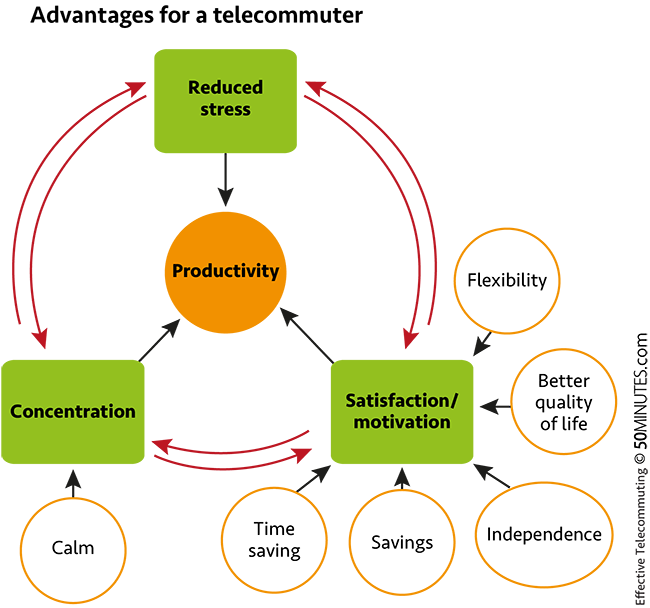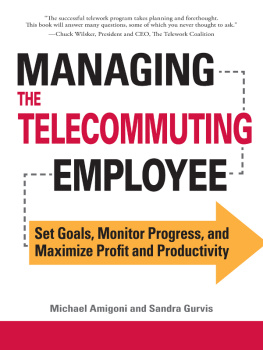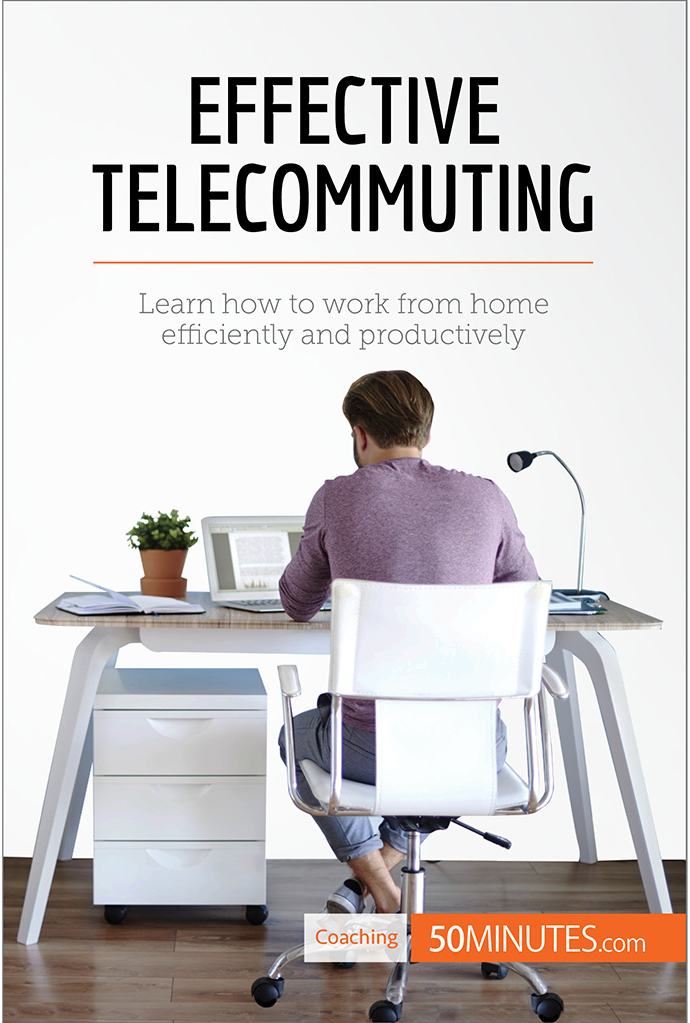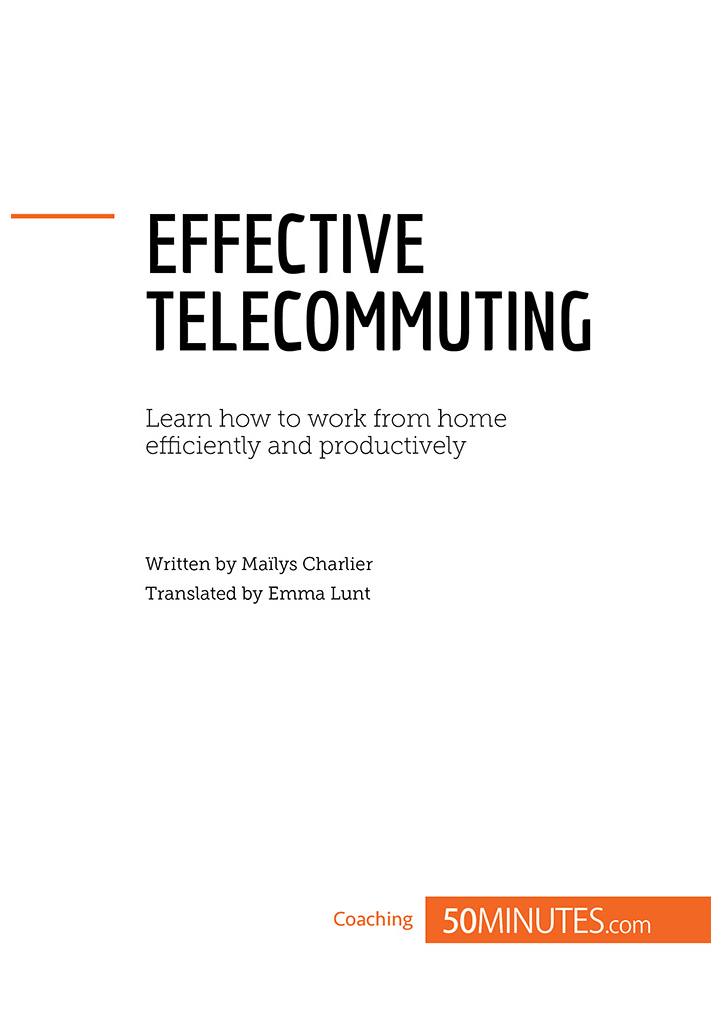A relatively recent idea, telecommuting (working from home) is increasingly common. Thanks to the age of Web 2.0, smartphones and the many communication apps, it has become easy for some jobs anyway to work from home. Working from home is often considered an advantage: we gain time as we are spared the commute to work; we also avoid the fatigue of public transport or car journeys and their share of daily traffic jams; we save money by not buying fuel or transport tickets; we can organise our day as we wish; we are free to do what we want during our lunch break; we avoid the frequent interruptions and distractions of the office.
But telecommuting is not a synonym for lazing around. You must learn to manage your time and improve your organisation, as well as to reserve a space specifically dedicated to your career. Your employer will often be even more demanding when you work at home. By allowing you to work from home, they are trusting you and thus reasonably expect productive work in return. It is therefore a good idea to seriously consider all the ins and outs of such a decision.
I have always had difficulty concentrating. When my employer allows it, I prefer working from home so as to avoid as many distractions as possible. But telecommuting requires great self-discipline! It is really not easy to be productive and to provide the expected work while alone in the house. (Emily, publisher)
Effective telecommuting: the basics
The vague term of telecommuting
According to UK law, telecommuting refers to any type of work that is done by an employee outside the organisations premises on a recurring basis, with the help of computer technologies. Working outside the companys premises does not necessarily mean working from your home: there are types of telecommuting that take place in either a co-working space, or on trips for some jobs.
There are different types of telecommuting: nomadic work, which involves being constantly on the go and carrying out your work outside the organisations premises (such as a salesperson or consultant); telecommuting at home, which involves working all week from home; part-time telecommuting, which is an alternative form of work meaning that the employee spends part of their time working from home and comes to work for some days within the organisation; and finally, collaborative work, which involves working on shared files with people that are geographically far away and they do this with groupware (software programmes that enable many people to share documents from a distance, such as Dropbox, Gmail, Skype, etc.).
This book looks at working from home and part-time telecommuting.
Why work from home?
The good reasons
For the worker, this method of organising work, which may be practiced on a full-time basis or one or two days per week the rest of the time being spent at the organisation presents numerous advantages.
- The worker will, theoretically, benefit from an all-around increase in quality of life (more time for themselves, satisfaction, motivation, better physical shape, etc.).
- The time saved by not commuting can be used for other things, like having an extra hours sleep, doing some sport in the morning, meditating, etc. This has a significant impact on health.
- They will suffer from less interruptions and distractions that can happen in a classic working environment (colleagues, open plan, etc.).
- As the employee is in a calmer environment, they will be more able to concentrate and, in theory, will be more productive.
Ive noticed that when I work from home, I am much more efficient and quick. It is easier to concentrate at your own house than at the office where it is difficult to think properly if a colleague is on the phone right next to you or when your colleagues are chatting together. At home, I am relaxed and nobody disturbs me. (Stephanie, journalist)
- They can save money on transport, meals, etc.
- Their motivation tends to increase as the employee is at home and has more independence regarding time management and the organisation of their work.
- They will have greater flexibility in case of a personal emergency, meeting, etc.
- Finally, telecommuting if well organised reduces stress during the day (no never-ending commutes, no stressed or stressful colleagues, etc.).

The employer also benefits from allowing employees who wish to telecommute to do so.
- There is a distinct drop in absenteeism and presenteeism.
- Telecommuting also generates more time for real work on the part of the employee: they waste less time on transport and are therefore more willing to have less or shorter breaks.
- As the employee is at home, they generally demonstrate greater flexibility: they are easily inclined to change their schedule or to work outside office hours.
Significant disadvantages
As with any type of work, however, there are also disadvantages to working from home, as much for the employer as for the employee. Thus, for the employee, there are aspects that are more difficult to manage:
- implementing specific framework;
- difficulty of supervising;
- reduction in team cohesion;
- increased risks of endangering confidentiality;
- potential extra material costs.
Defining measurable indicators
While it is difficult to control a telecommuters working hours, their productivity level and their efficiency are more easily measurable. In fact, as the employee works from home, they can regularly send reports detailing the tasks done each day. Their employer will then be able to evaluate their performance directly.
Implementing a telecommuting system can also require a small investment from the telecommuter at the start, such as creating an at-home office. But the main disadvantages regard contact with colleagues, as well as personal organisation, which must be vigorous. We will come back to these points later.
Before diving in
A suitable working space
Working from home is not suitable for everybody. While telecommuting is clearly based on the mutual consent of the telecommuter and the employer, it is also necessary to consider the material aspect, as working from home requires a good computer system and an available office too. Is that the case at my house? Can I rely on these different aspects? Or on a nearby coworking space? Am I prepared to make the necessary adjustments? These questions are important, as it is unrealistic to think that you can manage your regular working days on the kitchen table; you need a dedicated space, which is well-lit and calm.






















